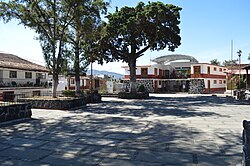Ihuatzio
Ihuatzio is a small, traditionally Purhepecha indigenous town on the shores of Lake Patzcuaro in Michoacan, Mexico. The town is known for its archaeological site with 1,000-year-old ruins that were occupied by two different pre-Hispanic indigenous cultures. Like many of the towns around Lake Patzcuaro, it has historically relied on Mexican artesanias for its livelihood: reed sculptures are the local specialty.
Understand
[edit]
Get in
[edit]There are combis that circle Lake Patzcuaro, dropping off passengers in whatever village they wish. These combis depart from the main plaza in Patzcuaro and are the cheapest way to get around.
Most tourists will find it more comfortable and far easier to simply take a taxi. Ihuatzio is only a 10-15 minute ride from Patzcuaro and the fare will probably be less than M$200 (but be sure to negotiate your rate before you get in the taxi).
If you are in another city in the region, take a bus to Patzcuaro, which has frequent service via the Purhepecha bus line.
Get around
[edit]See
[edit]
- 1 Plaza Principal, Vasco de Quiroga 86. The town's central park with manicured landscaping, towering shade trees, and park benches along paved walkways.
- 2 Parroquia de San Francisco de Asisi (St Francis of Asisi Church), 18 de Marzo (adjacent to Plaza Principal). Beautiful colonial era church built by Franciscan missionaries in the 16th century and extensively renovated between 1944 and 1947. The church contains a number of historic artworks including both traditional Christian themes and symbols and icons of the indigenous Purhepecha (also called Tarascan) culture. A sculpture of a wolf on the bell tower recalls the story of St Francis calming a marauding wolf who was terrorizing a village. Inside is an 18th-century sculpture of San Nicolás de Tolentino and a shrine to Our Lady of Sorrows. The church is surrounded by a peaceful courtyard and an old stone wall.
- 3 Capilla A Virgen De Guadalupe (Chapel of the Virgin of Guadalupe), Lázaro Cardenas 44. Small shrine built by the Franciscan monks and dedicated to Mexico's patron saint, the Virgin of Guadalupe.
Ihuatzio archaeological site
[edit]
Ihuatzio was first settled by the Toltec people around 900 AD. The Toltec built up the settlement which they occupied until about 1200 AD, after which it was occupied by the Purhepecha (also spelled Purépecha) until the time of the Spanish conquest. The site was abandoned around 1530.
Anthropologists think the site was important as a defensive outpost to support the defense of their nearby capital at Tzintzuntzán, however, there is also ample evidence that the site was a ceremonial hub dedicated to Curicaueri, the god of fire, and his fun-loving companion goddess, Xaratanga, who in addition to being the goddess of water, is associated with love, sex, and pulque. (Oh, yeahhhh.)
The archaeological site is fairly small with two large pyramids being the major points of interest. A site museum contains interpretive displays and shows several sculptures and other relics from the site. Ihuatzio is located just north of the modern-day village of Ihuatzio and is operated by INAH (Instituo Nacional de Antropologia y Historia). The site is open daily from 09:00 - 18:00 with the last admissions at 17:00. Entry costs M$75 per person. More information is on the official website.
Do
[edit]Buy
[edit]
When Don Vasco, the archbishop of Michoacan, was teaching villagers to specialize in trades some 300 years ago, he taught the natives of Ihuatzio to weave reeds, with the practical goal of fashioning baskets, chairs, and stools. Today, reed weaving continues to be practiced in the local community where some of the most popular works are fanciful sculptures of animals and mythical creatures, some of whom are worked into practical objects, such as an elephant supporting a coffee table on its back, or monkeys dangling a ceiling lamp. The reed sculptures are sold in marketplaces throughout the region, but if you're in Ihuatzio you can stop by Taller Tzumindi or one of the other workshops and watch the craftsmen at work.
- 1 Taller Tzumindi, Independencia 88, ☏ +52 434 144 1347. Daily 09:00 - 18:00. Large selection of woven reed furniture and sculptures. Good selection of baskets in varying sizes from small handbaskets to large trunks. Tables, chairs, wardrobes and more. Sculptures include revolutionary heroes, jaguars, alligators, buffalo and more.
- 2 Artesanías "Jiuatsï Urapiti", Independencia #1000. Daily 11:30 - 18:30. Small workshop where you can observe craftsmen fashioning their woven reed objects. Many types of baskets, furniture, and small household decorative objects (wastebaskets, tissue holders, etc.)
Eat
[edit]- 1 Kurhinta, Tariacuri 2, ☏ +52 434 100 8777. W F Sa 17:00 - 23:00, closed Su M Tu Th. Good pizzas but erratic hours.
Drink
[edit]Sleep
[edit]There are no hotels in Ihuatzio, though there are a couple of lakeside resorts heading towards Tzintzuntzan. A large selection of rooms is available in Patzcuaro.


 Français
Français Italiano
Italiano




